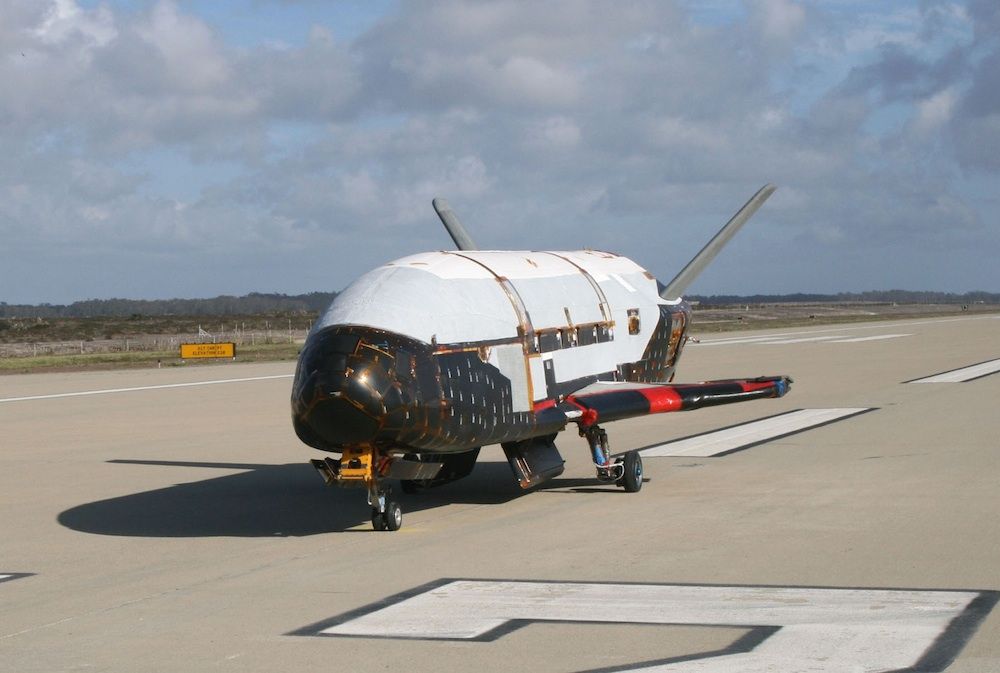X-37B Space Plane Returns: 5 Theories About Its Secret Mission

After spending nearly two years in orbit on a secret mission, the U.S. Air Force's mysterious X-37B space plane landed today (Oct. 17) at Vandenberg Air Force Base in California. The unmanned, reusable vehicle logged an unprecedented 675 days in space, but very little is known about the record-setting flight.
The X-37B, also known as the Orbital Test Vehicle, touched down at the Vandenberg Air Force Base today at 9:24 a.m. local Pacific Time (12:24 p.m. EDT). It was the third in a series of flights that the Air Force has conducted using its two X-37B planes.
This most recent flight, called OTV-3, was the third one to make it into orbit and was the longest mission, at 675 days. The program's inaugural mission launched in April 2010 and lasted 225 days. The space plane's second mission lasted 469 days. [Flying Saucers to Mind Control: 7 Declassified Military & CIA Secrets]
"I'm extremely proud of our team for coming together to execute this third safe and successful landing," Col. Keith Balts, commander of the 30th Space Wing, headquartered at Vandenberg, said in a statement.
But what has the space plane actually been doing in orbit? The top-secret nature of the X-37B missions has sparked a number of conspiracy theories. Here are some ideas about the X-37B's purpose:
Surveillance
While the United States military has plenty of surveillance satellites in orbit, some people have suggested that the X-37B has high-tech monitoring gear designed to keep an eye on certain regions of Earth. "X-37B is probably carrying prototype reconnaissance gear, for spying on the Middle East and other sensitive geopolitical regions," said ExtremeTech.com. So what's the advantage of using a space plane to spy instead of a satellite? The plane likely can move to a region of interest faster than a satellite can, Business Week reported, although others have pointed out that the fuel requirements for doing this would likely be prohibitive.
Sign up for the Live Science daily newsletter now
Get the world’s most fascinating discoveries delivered straight to your inbox.
Space bombing
While conspiracy theorists have jumped on this notion, Popular Mechanics dumped cold water on the idea. "Changing a spacecraft's orbital plane requires a great amount of thrust — so using something like the X-37B as a bomber would mean changing its orbit to fly over targets, and that would eat up its limited fuel supply," Popular Mechanics stated, quoting University of Maryland professor Mark Lewis, a former Air Force chief scientist.
Interfering with other satellites
Another idea is that the X-37B is, in the style of James Bond, supposed to take out other satellites that are making the U.S. government nervous. But, unless the plane is somehow conducting these nefarious activities from far away while not moving around very much, some suggest this is unlikely. "It would be very easy to trace that sort of activity back to the U.S. government since governments and amateurs alike can easily track the X-37B," the Daily Beast reported.
Spying on the Chinese space station
Just before the X-37B launched, BBC and Spacefllight Magazine published reports suggesting that the orbit of the vehicle is close enough to watch what's going on with China's Tiangong-1 space station. Space analyst Jim Oberg, however, told BBC that this would be impossible. "They are in orbits which cross the equator about 90 degrees apart. They crisscross each others' paths at thousands of meters per second. Any observation from one to the other is impossible," he said.
Deploying spy satellites
Perhaps instead of interfering with satellites, the X-37B sends out its own. The space plane's 2011 mission, at the least, carried it over the same regions of the Earth repeatedly, similar to the motions of satellites, so perhaps it released probes into a similar orbit. In a New York Times report, several amateur observers watching the space plane said that it flies over the same area of the planet every four days, which is expected of a reconnaissance satellite.
Follow Live Science @livescience, Facebook & Google+. Original article on Live Science.

Elizabeth Howell was staff reporter at Space.com between 2022 and 2024 and a regular contributor to Live Science and Space.com between 2012 and 2022. Elizabeth's reporting includes multiple exclusives with the White House, speaking several times with the International Space Station, witnessing five human spaceflight launches on two continents, flying parabolic, working inside a spacesuit, and participating in a simulated Mars mission. Her latest book, "Why Am I Taller?" (ECW Press, 2022) is co-written with astronaut Dave Williams.
Most Popular

